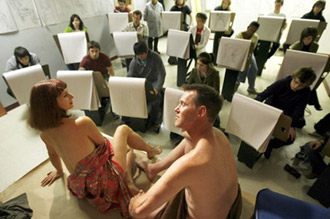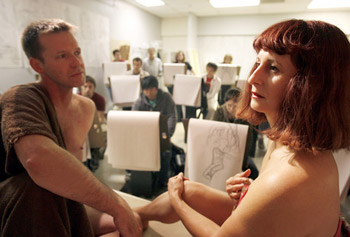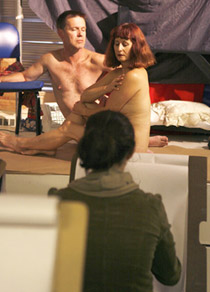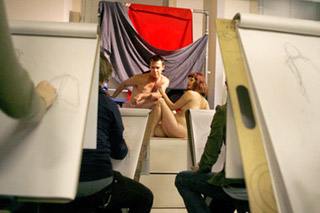
Naked ambition: Inside the curious world of nude modeling for artists
By William Hageman | Tribune staff reporter
source:
Chicago Tribune
赤裸裸的野心
內窺藝術家們令人好奇的裸體寫真世界
Art models, Meg Guttman and Rex Troxell model for students at the American Academy of Arts. (Tribune photo by Antonio Perez / December 1, 2008)
Rex Troxell has this dream.
"I can't get my clothes off," he says. "You're trying to get them off, and you can't."
For most of us, being unable to get naked in public is hardly a nightmare. But Troxell is an art model. And posing in the nude, something he has done for 30 years, is key to bringing home a paycheck.
With its plethora of art schools, college art classes, art leagues and private artists, Chicago and the suburbs are home to an estimated 50 to 150 working art models at any given time, according to those in the business. It's a group that comes in all shapes, ages, sizes and backgrounds.
"We couldn't teach classes without professional models," said Duncan Webb, the academic dean at the American Academy of Art in Chicago and an artist himself. "They are essential," said Nancy Rosen, a local artist who works in mixed media. "The model brings everything to the room."
Models are often students or members of the art or theater communities. Troxell says one model at Chicago's American Academy of Art was an electrical engineer in Russia, and another has a doctorate in chemistry and formerly taught at the University of Illinois in Urbana-Champaign.

"Some of the women are married and have a family at home," he said. As for body type, Rosen is all-inclusive. "I'll take anybody on. From very skinny to completely obese. And everything in between. That's who we are."
"Artists don't want models to all look alike," agreed Mandy Corrado, 27, of Evanston, who modeled while a student at the Art Institute of Chicago. "They appreciate models for their uniqueness and differences. Artists can look at people of all shapes and sizes and see beauty in them. ... To be accepted by artists for who you are and what you look like, without being judged, is liberating."
Still, using all types of models can meet resistance, Rosen said.
"If you're in a classroom or in workshop situations, [students] have very big responses to that. They'll be like, 'I don't want to draw her;,she's too fat. I don't want to draw her; she's too skinny. I don't want to draw him; he's a him.' "
Then it's up to the teacher to set people straight.
"Today we are drawing this person," Rosen said she tells students. "That's what's so interesting about drawing from life. ... Somebody's willing to sit there for us. They're sacred. And they should be treated as such. They're a gift."
It's not only students who might have the wrong image of art models.
"In society at large, it's quite misunderstood," said Corrado, who is now the assistant to the director of human resources at a Chicago company and a working artist. "For example ... people I tell [that she used to model], they look at me funny, they look at me weird, like, 'Oooh, a sex worker.'."
Chicagoan Meg Guttman, 53, who began modeling while at Yale and has been doing it regularly since she moved here 22 years ago, has seen the look that comes over people's faces.
"When you say you're an art model there's this pause," she said. "And you know what they're thinking. You can almost tell them before they say anything. 'Yes, I do take my clothes off.' "
"I think a lot of people wonder what kind of person would take their clothes off in front of other people," adds Troxell, 59, who lives in Libertyville and models between 27 and 40 hours a week. "I don't think they're able to rationalize the idea that it's a job."
And nudity is part of that job, Webb says.
"It goes back, really, to the Renaissance," he said. "The underlying thought is you draw from a live model to develop your visual thinking skills, develop a strong foundation that you can use in whatever medium you choose. ... You can see, like, these drawings, Raphael drawing the nude figure in a study for a finished clothed figure in a painting. "Thinking about the education side of it, the human figure provides almost limitless teaching opportunities. You're talking about volume, mass, light, structure, anatomy, all these key concepts that an artist needs to learn."

Modeling sessions usually go for three hours, but some can last three or four times that long. And no one gets rich--the going rate is $25 an hour, though some places offer as little as $16. It's an occupation you need to have your heart in.
Rosen knows it; she has filled in as a model on an emergency basis.
"It's hard work," she said. "You sit there, and the way it goes is it's 25 minutes and you get a 5-minute break. It's a very long time to sit, sit and not move. Somebody is drawing your toe, somebody is drawing your hips. Somebody is drawing your eyes. And you can't move anything. It's a very difficult thing."
Rather than hang out socially, members of Chicago's modeling community tend to form a loose support network. They see each other frequently, often working for the same teachers or artists, so they are generally somewhat familiar with each other.
When she was modeling--she stopped a couple of years ago--Corrado had a list of 75 other models with whom she was in frequent contact, passing on news about jobs, artists who shortchanged models or guys to watch out for.
And yes, there is sometimes that ewwwwww factor.
Corrado tells of a robe she used to wear, black silk with red flowers. Artists loved it. Sometimes too much.
"I'd hate it when they'd say, 'Keep your robe on. Just drape it, just show one breast.' I'd go, 'Oh, I'd rather be naked.' I mean, [their suggestion was] seductive, erotic. ... In a group setting? 'Show this, show that.' Ooohhh."

But by and large, it's an occupation they love.
"I feel like I'm making people better artists," said Guttman. "Even the people who aren't great, they show up on a Monday morning at an art center somewhere."
Rosen says she thinks she knows one reason models enjoy their work.
"Whenever I have a new model who hasn't modeled before, it's interesting to watch them figure out the whole dynamics of the room. Like, Can I talk? Should I not talk? Can I look at people's work? Do I not look at their work? And to watch them walk around the room at the break and start seeing themselves come alive.
"You've got 20 people in the room, and you've got 20 people drawing you differently. That's a fascinating thing. I actually think that's a big draw for models, to see people keep making you."
